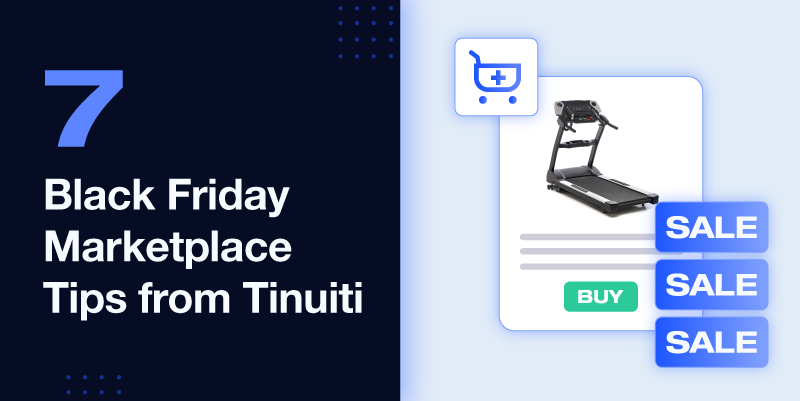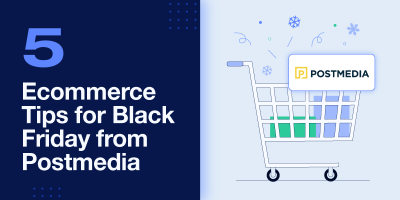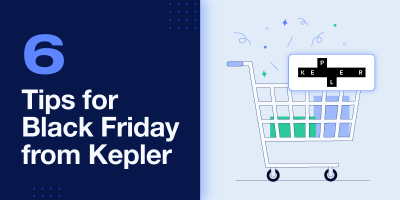Shoppers are ready to take advantage of Black Friday, but what about sellers? Are you ready to make the most of your marketplace opportunities this shopping season? We spoke to Pat Petriello, Director of Amazon Strategy at Tinuiti, to collect his ecommerce tips for succeeding in Q4.
This is the second installment of our “Sell More on Black Friday” series; make sure you check out the contributions from Kepler and Postmedia for more great insights like the ones below.
1. Shoppers expect big discounts; a temporary reduction in profits can still pay off
The most important dynamic for brands to prioritize is shopper intent and what their customers care about. During the “Turkey Five” Thanksgiving to Cyber Monday period, shoppers are looking for deals, discounts, and value. Anything less than at least a 20% discount isn’t going to materially get the attention of shoppers in the market. While the cons might be a short-term reduction in profit, brands need to think of the big picture. For many customers, this might be the first time they’ve ever interacted with a brand, and making a good impression is the start of long-term engagement and repeat customer value.
2. The table stakes are the same for businesses of any size
At its core, the approach on Black Friday doesn’t differ vastly between challenger brands and enterprise brands. Quality products, thoughtful, accurate, and informative detail pages, meaningful price discounts, and a full-funnel advertising approach are all key inputs to driving success. Enterprise brands may have more significant budgets, which means they can go wider with reach and exposure—such as investing in Amazon category page placements—but it all goes back to how you are adding value to the customer.
3. With a large budget, you should tap into newer options that increase visibility
With a larger budget, a brand can really lean into more streaming TV and online video opportunities, as well as newer platforms, such as Amazon’s Thursday Night Football package. There are also more arrows in the quiver in the form of influencer marketing and off-Amazon media buying to get the broadest visibility. The key is not to take actions just for the sake of taking them, but to be intentional around your inputs and objectives.
4. Even on marketplaces, you should optimize the customer experience
If you want to succeed on marketplaces, make it easy for customers to choose your products. Don’t put the work on them to understand the value proposition of your product or to find your product multiple times. On Amazon specifically, make sure your Amazon store is fully optimized and features in-stock products. I recommend creating a dedicated “holiday deals” section that shoppers can easily navigate to and you can send off-Amazon traffic to. Do the work for your customers and they will reward you with consideration and a purchase.
5. Consider how multiple channels work together to drive purchases
A multichannel strategy is extremely powerful, but its success is highly dependent on both the channels a brand operates in, and the available budget. Don’t just think in terms of sales; separating consumers into categories, such as “Amazon shoppers,” “Google shoppers,” or “TikTok shoppers,” is outdated and counterproductive. Humans are complex. We search on Google, get ads on Instagram, shop in-store, check prices on Amazon, etc. Be present where your customers like to spend their time.
6. Quality products generate brand loyalty on their own, so focus on “growing your pond”
Brand loyalty is always important, and it needs to be earned. There’s no amount of ad wizardry or campaign optimization that is going to overcome having poor quality products. Your customers are smart, and they have options—you have to start with actual quality to earn loyalty.
When you’re allocating your budget to either reach new customers or retarget existing customers, the brands that have the discipline and commitment to “growing their ponds” always come out on top. If you “overfish your pond” by only harvesting bottom-of-the-funnel, high-intent keywords and brand searches, you are going to run out of fish at some point, or your fish are going to come at a very high cost-per-click. The more energy you put into reaching new customers today, the higher your growth ceiling becomes.
7. Black Friday and Cyber Monday will exacerbate the unresolved problems in your business
Brands often get excited about the potential for a huge sales period and either overcomplicate things or lose sight of the basics. You can do everything I’ve laid out above, but if you run out of inventory or can’t fulfill products, you’ve failed.
Metaphors incoming… The Turkey Five period is a marathon, and you need to train hard before the event if you expect to have a good race. If you plan on using the marathon (i.e. Black Friday, Cyber Monday) to get yourself in shape, you’re in trouble. Also, the Turkey Five period does not exist in a vacuum—it leads into the rest of the Q4 shopping season. If you’ve just engaged with a completely new set of shoppers and potential shoppers, nurture that growing pond and watch it thrive along with your business.

Director, Amazon Strategy at Tinuiti
An experienced digital marketer, Pat leads a team in identifying growth opportunities for Tinuiti’s global Amazon clients and building durable, scalable solutions to serve them. A former professional seller on Amazon.com, Amazon.co.uk, eBay, Buy.com and former member of Amazon’s Seller Service Team, Pat offers unique insights and was instrumental in building the Amazon service line at Tinuiti (f.k.a CPC Strategy). A respected expert on all things Amazon, Pat serves as a valued resource training in-house and client teams on marketplace fluency.
Energetic, engaging and always informative, Pat has been a featured speaker at Amazon AdCon, unBoxed, Prosper, AdDiego, AdNYC and Digital Summit.
Pat hails from New Jersey and earned his B.S. in Marketing at University of Maryland, and his M.S. in Sports Business from NYU. He now calls San Diego home.




